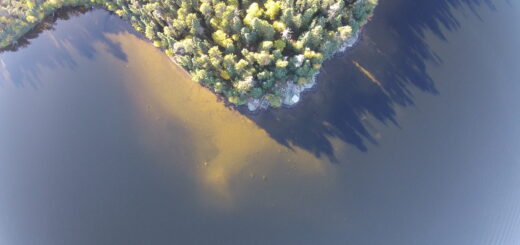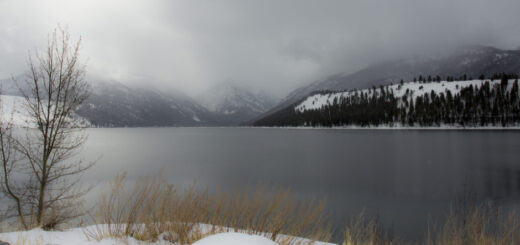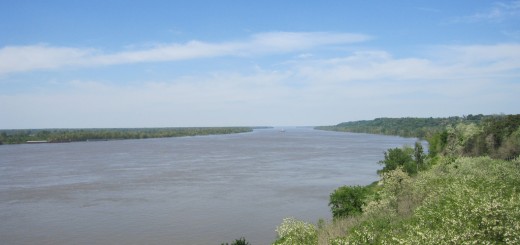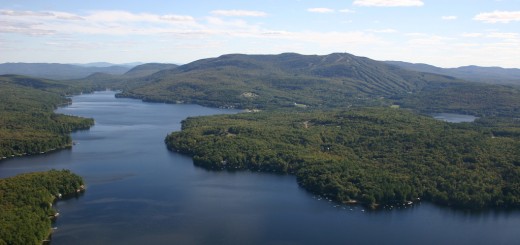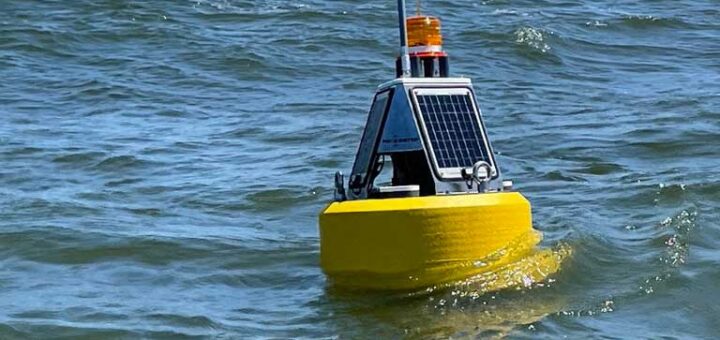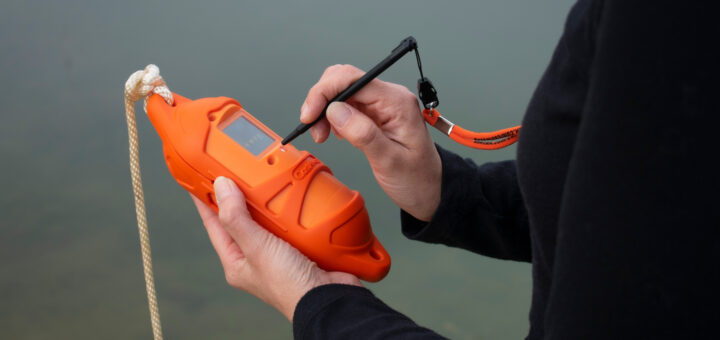Research Brief: Research Needed for Global Sustainable Lake Restoration
0Global lake restoration efforts have been unsustainable due to a lack of intentional monitoring and research, causing repetitive treatments and increasing costs.
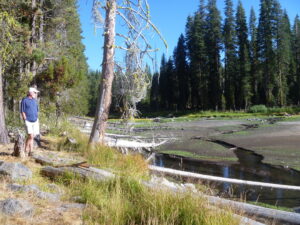
A visitor observes the Dream Lake restoration process from the north shore. (Credit: Lassen NPS via Flickr CC BY 2.0)
Eutrophication resulting from nutrient pollution continues to be a considerable cause of poor lake ecosystem health, making nutrient reduction the standard method of lake restoration.
Declining success rates of lake recovery programs and forecasted increases in pressures caused by climate change put preventing further deterioration at the forefront of limnological research. Sustainable lake restorations can boost system resilience against various stressors and reduce greenhouse gas emissions caused by deoxygenated carbon- and nitrogen-enriched sediments from increased eutrophication.
A 2023 study published in WIREs Water assesses the ability to achieve sustainable lake restoration results by linking environmental, social, political, and economic factors together through multidisciplinary research to overcome ecological, financial, and social challenges. The goal of the study was to examine restoration measures, evaluate the positives and negatives of these measures, and identify areas for future research.1
Methods
Researchers first introduced the parameters by which they define sustainable lake restoration followed by observing specific lake restoration projects. Sustainable lake restoration is defined simply as improving a water body’s ecological state with several additional environmental benefits and ecosystem services.
Seven lakes were examined to assess the effectiveness and sustainability of the in-lake restoration measures occurring at each of the case study lakes. Each lake utilized a different restoration strategy.
Lakes Mustijärv and Ormstrup used sediment removal dredging/excavation removing excess phosphorus and nitrogen loading from lake ecosystems. In this case, the nutrients were then reused in agricultural practices.
The Myllypohja basin in Lake Kymijärvi used hypolimnetic withdrawal, pumping and slowly separating excessive nutrients from the lake water.
Lakes Vesijärvi and Pyhäjärvi used biomanipulation by removing planktivorous and bottom-feeding fish, which can improve water quality and nutrient levels. Similarly, Lakes Vuotunki and Taihu removed and recycled macrophyte and phytoplankton biomass.
While the researchers focused on seven case studies for long-term assessment, they also listed aeration and chemical treatments as possible strategies that are used in other lakes across the globe. The aeration technique includes using a submerged system that oxygenates the lake, improving dissolved oxygen and promoting circulation. The chemical treatments bonded phosphorus to minerals and clay (Al/Fe/Ca salts, lanthanum-modified bentonite) immobilizing the phosphorus in the watershed.
Researchers determined that previous research excluded why specific short-term measures were chosen instead of long-term solutions. The report suggests that an entire system analysis, including a lake and socio-economic assessment, can improve restoration initiatives and encourage a more sustainable long-term approach to lake restoration.
Researchers evaluated the sustainability of each lake’s restoration method, particularly the effectiveness, costs, environmental risk, and contribution to a circular economy. To verify their investigation, researchers examined seven individual lake case studies and analyzed each according to the restoration measures’ effectiveness and contribution to a circular economy.
Results
Most measures in the seven case studies were proven effective, but monitoring must continue in order to ensure total long-term sustainability.
Lakes Vesijärvi and Pyhäjärvi successfully used biomanipulation to contribute to the local food industry. However, researchers stress overfishing must be avoided through sustainble fishing practices and fishery monitoring.
Lakes Mustijärv and Ormstrup show mixed results due to a lack of solid evidence that sediment reuse works. Both lakes have promising results, but researchers contrast the success with other studies showing poor results. Researchers recommend collecting more evidence on whether reuse works and ensuring extensive monitoring occurs to confirm the sediment isn’t contaminated.
The Myllypohja basin in Lake Kymijärvi proves hypolimnetic pumps that slowly separate excessive nutrient supplies from the water have a 15-20 year turnover but can successfully prevent decades of eutrophication. While the method helped remove contaminated sediment, the researchers concluded that recycling withdrawn nutrients is still largely unexplored.
Lake Vuotunki and Taihu show that removal of macrophyte and phytoplankton biomass was successful, but complicated future treatments, posing environmental and ecological risks. The researchers stressed that introduction of invasive species must be avoided during recycling.
Removing nutrients, sediments, and biomass to then be recycled into agriculture, food, or biogas production achieves sustainable lake restoration and contributes to a circular economy. However, the gap in monitoring and knowledge of these approaches revealed the necessity for future multidisciplinary research.
The study suggests there isn’t a single measure for all lakes; instead, each lake should be individually monitored to guarantee the measure chosen is the best one for the ecosystem and surrounding communities. Researchers suggest that entire community support is required to consider all lake and socio-economic concerns.
Sources
- Tammeorg, O., Chorus, I., Spears, B., Nõges, P., Nürnberg, G. K., Tammeorg, P., Søndergaard, M., Jeppesen, E., Paerl, H., Huser, B., Horppila, J., Jilbert, T., Budzynska, A., Dondajewska-Pielka, R., Gołdyn, R., Haasler, S., Hellsten, S., Härkönen, L. H., Kiani, M., … Lürling, M. (2024). Sustainable lake restoration: From challenges to solutions. WIREs Water, 11(2), e1689. https://doi.org/10.1002/wat2.1689




